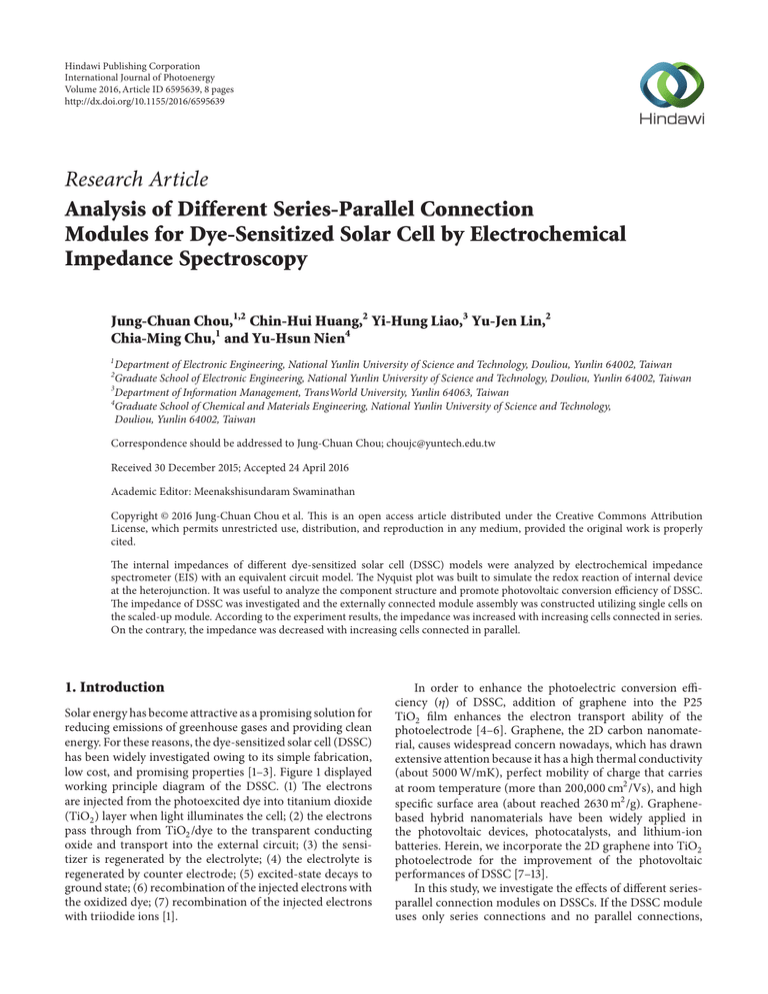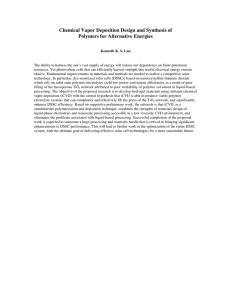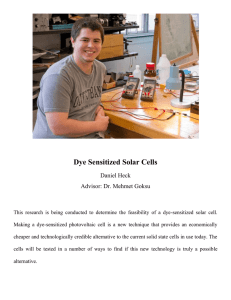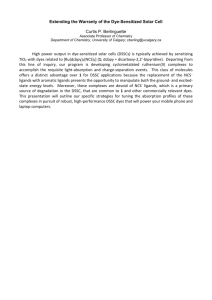Analysis of Different Series-Parallel Connection Modules for Dye
advertisement

Hindawi Publishing Corporation International Journal of Photoenergy Volume 2016, Article ID 6595639, 8 pages http://dx.doi.org/10.1155/2016/6595639 Research Article Analysis of Different Series-Parallel Connection Modules for Dye-Sensitized Solar Cell by Electrochemical Impedance Spectroscopy Jung-Chuan Chou,1,2 Chin-Hui Huang,2 Yi-Hung Liao,3 Yu-Jen Lin,2 Chia-Ming Chu,1 and Yu-Hsun Nien4 1 Department of Electronic Engineering, National Yunlin University of Science and Technology, Douliou, Yunlin 64002, Taiwan Graduate School of Electronic Engineering, National Yunlin University of Science and Technology, Douliou, Yunlin 64002, Taiwan 3 Department of Information Management, TransWorld University, Yunlin 64063, Taiwan 4 Graduate School of Chemical and Materials Engineering, National Yunlin University of Science and Technology, Douliou, Yunlin 64002, Taiwan 2 Correspondence should be addressed to Jung-Chuan Chou; choujc@yuntech.edu.tw Received 30 December 2015; Accepted 24 April 2016 Academic Editor: Meenakshisundaram Swaminathan Copyright © 2016 Jung-Chuan Chou et al. This is an open access article distributed under the Creative Commons Attribution License, which permits unrestricted use, distribution, and reproduction in any medium, provided the original work is properly cited. The internal impedances of different dye-sensitized solar cell (DSSC) models were analyzed by electrochemical impedance spectrometer (EIS) with an equivalent circuit model. The Nyquist plot was built to simulate the redox reaction of internal device at the heterojunction. It was useful to analyze the component structure and promote photovoltaic conversion efficiency of DSSC. The impedance of DSSC was investigated and the externally connected module assembly was constructed utilizing single cells on the scaled-up module. According to the experiment results, the impedance was increased with increasing cells connected in series. On the contrary, the impedance was decreased with increasing cells connected in parallel. 1. Introduction Solar energy has become attractive as a promising solution for reducing emissions of greenhouse gases and providing clean energy. For these reasons, the dye-sensitized solar cell (DSSC) has been widely investigated owing to its simple fabrication, low cost, and promising properties [1–3]. Figure 1 displayed working principle diagram of the DSSC. (1) The electrons are injected from the photoexcited dye into titanium dioxide (TiO2 ) layer when light illuminates the cell; (2) the electrons pass through from TiO2 /dye to the transparent conducting oxide and transport into the external circuit; (3) the sensitizer is regenerated by the electrolyte; (4) the electrolyte is regenerated by counter electrode; (5) excited-state decays to ground state; (6) recombination of the injected electrons with the oxidized dye; (7) recombination of the injected electrons with triiodide ions [1]. In order to enhance the photoelectric conversion efficiency (𝜂) of DSSC, addition of graphene into the P25 TiO2 film enhances the electron transport ability of the photoelectrode [4–6]. Graphene, the 2D carbon nanomaterial, causes widespread concern nowadays, which has drawn extensive attention because it has a high thermal conductivity (about 5000 W/mK), perfect mobility of charge that carries at room temperature (more than 200,000 cm2 /Vs), and high specific surface area (about reached 2630 m2 /g). Graphenebased hybrid nanomaterials have been widely applied in the photovoltaic devices, photocatalysts, and lithium-ion batteries. Herein, we incorporate the 2D graphene into TiO2 photoelectrode for the improvement of the photovoltaic performances of DSSC [7–13]. In this study, we investigate the effects of different seriesparallel connection modules on DSSCs. If the DSSC module uses only series connections and no parallel connections, 2 International Journal of Photoenergy E Light S∗ ECB LUMO EF qVoc (7) (6) (5) (1) Red. (4) Pt Ox. (3) S/S+ Conductive substrate Conductive substrate (2) HOMO Electrolyte Power TiO2 particle Dye Figure 1: Working principle scheme of the dye-sensitized solar cell [1]. which can obtain easily higher voltage, but a module assembly is impossible to convert electrically because of lower current. Thus, an appropriate level parallel connection in the DSSC module assembly must be fabricated to produce current, composing parallel module assembly with minimum loss that is essential. That is to say, it is important to maintain large internal shunt resistance (𝑅SH ) in the module assembly. The current loss is caused by decrease of internal shunt resistance, which can be inhibited by proper series connected [1]. 2. Materials and Methods 2.1. Materials. Graphite powder was purchased from Enerage Inc., Taiwan. Titanium dioxide (TiO2 ) powder and Ruthenium-535 (N3) were purchased from UniRegion Bio-Tech, Taiwan. The ethanol was purchased from Katayama Chemical, Japan. The Triton X-100 was purchased from PRS Panreac, Spain. The Acetylacetone (AcAc), lithium iodide (LiI), and 4-tert-butylpyridine (TBP) were purchased from SigmaAldrich, USA. The iodine (I2 ) was purchased from Riedelde Haen, USA. The 1-propyl-2,3-dimethylimidazolium iodide (DMPII) was purchased from Tokyo Chemical, Japan. 2.2. Fabrication of Dye-Sensitized Solar Cell. The synthesis of graphene oxide (GO) was reported in our previous paper [14]. The graphene/TiO2 paste consisted of P25 TiO2 powder, deionized water, Triton X-100, acetoacetone (AcAc), and graphene oxide solution, which were mixed by an ultrasonic cleaner for 10 minutes. The graphene/TiO2 paste was coated on fluorine doped SnO2 -coated conductive (FTO) glass by spin-coated method. Then the graphene/TiO2 layer was annealed at 550∘ C for 30 minutes as the working electrode. The working electrode was immersed in 3 × 10−4 M N3 dye solution. Platinum (Pt) layer was deposited for 90 seconds on the FTO-glass substrate as the counter electrode by using radio frequency (R.F.) sputtering system. After that the cell was sealed by Surlyn to form a sandwich structure. And the electrolyte solution consisted of 0.6 M 1-propyl-2,3dimethylimidazolium iodide (DMPII), 0.5 M lithium iodide (LiI), 0.05 M iodine (I2 ), and 0.5 M 4-tert-butylpyridine (TBP) in 15 mL 3-methoxypropionitrile (MPN). The active area of working electrode was approximately 0.57 cm2 . A module assembly was fabricated with variations module assemblies by copper tape, using 8 DSSCs module assembly and having module areas of 16.32 cm2 . Moreover, the total effective area of module assembly was approximately 4.56 cm2 . 2.3. Characteristic and Photoelectric Properties of Graphene/ TiO2 Composite Films. The short circuit current density-open circuit voltage (J-V) curves and photovoltaic characterizations of the DSSCs were carried out by using a Keithley 2400 source meter. A solar light simulator (MFS-PV-BasicHMT, Taiwan) was used to simulate sunlight under one sun AM1.5 G (100 mW/cm2 ) illumination provided by a 1000 W Xenon (Xe) lamp. The electrochemical impedance spectroscopy (EIS) measurements were performed using an electrochemical analyzer (BioLogic SP-150, France) with forward bias of 0.70 V in the dark. The impedance spectra were recorded by EC-lab software within the frequency range from 50 mHz to 1 MHz by applying an AC perturbation signal of 10 mV. 3. Results and Discussion 3.1. Characterization of Graphene/TiO2 Composite Film. The photoelectrode of DSSC is composed of graphene/TiO2 composite film. The surface morphology of graphene/TiO2 composite film has been investigated using SEM. Figure 2 showed top-view SEM image of graphene/TiO2 composite film. As shown in Figure 2, graphene/TiO2 composite film had higher specific surface area, which attributed to the lower crystallinity and TiO2 nanoparticles that were attached on the graphene easily [14–16]. 3.2. Photovoltaic Characterizations of DSSCs. An appropriate level parallel connection in the DSSC module assembly must be fabricated to produce current, composing parallel module assembly with minimum loss that is essential [17, 18]. That is to say, it is important to maintain large internal shunt resistance (𝑅SH ) in the module assembly. The current loss is caused by decrease of internal 𝑅SH , which can be inhibited by proper series connected [1]. Figure 3 showed real diagram of DSSC module assemblies. The module assembly was fabricated by 8 DSSCs, and these cells were listed in Table 1. The average 𝑉oc , 𝐽sc , FF, and 𝜂 of these cells were 0.648 V, 14.136 mA/cm2 , 37.053%, and 3.008%, respectively. 3.3. Effect of Different Series-Parallel Connection Modules on Impedance Spectrum. As shown in Figure 4(a), the equivalent circuit of DSSC is demonstrated by using EIS. In the International Journal of Photoenergy 3 sum of 𝑅S and 𝑅SH is expressed as 𝑅, in which the output current (𝐼O ) is equal to “(𝑅SH × 𝐼S )/𝑅,” but 𝐼O is generally similar with 𝐼S because 𝑅SH is much larger than RS [1]. The internal resistance, the characterization of electron and charge transportation, and diffusion between interfaces were simulated by an RC parallel circuit [19]. The equivalent circuit model was described as follows: 𝑅1 + Figure 2: SEM images of graphene/TiO2 composite film. Working electrode Copper tape Counter electrode Figure 3: Real diagram of DSSC module assemblies. Table 1: Photovoltaic properties of DSSCs. Sample 1 2 3 4 5 6 7 8 Standard deviation (𝛿) Mean 𝑉oc (V) 𝐽sc (mA/cm2 ) F.F. (%) 𝜂 (%) 0.63 0.62 0.70 0.67 0.66 0.64 0.63 0.63 14.96 13.96 13.05 13.75 13.92 14.45 14.52 14.48 37.69 37.52 35.04 36.76 36.94 37.35 37.40 37.72 3.15 2.88 2.85 3.00 3.01 3.05 3.06 3.06 0.027 0.592 0.881 0.099 0.648 14.136 37.053 3.008 equivalent circuit of DSSC, a diode represents the electrical properties of the pn-junction, and a 𝑅SH and a constantcurrent source (𝐼S ) are in parallel with the junction, where 𝑄1 and 𝑄2 can be ignored in DC analysis because capacitances are too large, approximately 10 𝜇F/cm2 and 1 mF/cm2 , respectively. As shown in Figure 4(b), the equivalent circuit of DSSC can be simplified to Norton’s equivalent circuit theorem by a current source (𝐼S ) with series resistance (𝑅S ) and 𝑅SH in parallel, where the sum of 𝑅1 , 𝑅2 , 𝑅3 , and 𝑊4 is expressed as 𝑅S . Also, the equivalent circuit of DSSC can be simplified to Thevenin’s equivalent circuit theorem by a voltage source 𝑉S with 𝑅S and 𝑅SH in series, as shown in Figure 4(c). And the 𝑅2 (𝑅3 + 𝑊4 ) + , 𝑄1 𝑄2 (1) where 𝑅1 corresponds to the serial resistances of FTO-glass and wires are at the high-frequency region. 𝑅2 and 𝑄1 correspond to the resistance and double layer capacitance of the electrolyte/Pt-FTO interface. 𝑅3 and 𝑄2 correspond to the resistance and chemical capacitance of the TiO2 /electrolyte interface. 𝑊4 is the Warburg impedance, which describes the diffusion of I3 − in the electrolyte. The symbol 𝑄, also known as constant phase elements (CPE), describes the constant phase element of the capacitance, meaning a nonideal frequency dependent capacitance due to a nonuniform distribution of current by the material heterogeneity [4, 20, 21]. As shown in Figures 5(a) and 5(b), the cells were connected module assembly in series connection, which was represented as S, two cells in series were denoted as 2S, and so on. In the series-connected models, the impedance was enlarged with increasing module assemblies in series connection, which could be attributed to the longer conductive path for electron. The longer conductive path for electron would easily make the condition of electron recombination happen during the electron transfer from conduction band of TiO2 to I3 − in electrolyte. Besides, the result of series connection was beneficial to raise voltage of DSSC, but the current density of DSSC remained unchanged. On the other hand, Figure 6 showed that the module assemblies were fabricated in parallel connection, where parallel connection was represented as P, two cells in parallel were represented as 2P, and so on. In the parallel connected models, the impedance was reduced with increasing module assemblies in parallel connection, which could be attributed to more conductive paths for electron. Besides, the result of parallel connection was beneficial to raise current but the voltage remained unchanged. In the series-parallel connected models, series connection can maintain large shunt resistance. Figure 7(a) showed the series-parallel connected models by composing 2 series connections and 4 parallel connections, where 2 series connections and 4 parallel connections were represented as 2S4P. The total internal shunt resistance was equal to 1/2𝑅SH . Therefore, the number of series connected DSSCs is less than the number of parallel connected DSSCs, in which the total internal shunt resistance is lower than one cell, in spite of the additional parallel connections [1]. On the contrary, Figure 7(b) showed the series-parallel connected models by composing 4 series connections and 2 parallel connections, where 4 series connections and 2 parallel connections were represented as 4S2P. The total internal shunt resistance was equal to 2𝑅SH . 4 International Journal of Photoenergy R2 RSH R1 RS RS ISH ID IS IO Q1 R3 IS Q2 W4 IO RSH (a) (b) IO RS RSH VS ± (c) Figure 4: (a) Equivalent circuit of DSSC; simplified equivalent circuit of DSSC by (b) Norton’s equivalent circuit theorem; (c) Thevenin’s equivalent circuit theorem [1]. 250 1800 200 1200 −Im(Z) (Ohm) −Im(Z) (Ohm) 1500 900 600 150 100 50 300 0 0 0 1000 2000 3000 4000 5000 0 150 Re(Z) (Ohm) 1 cell 2S cell 3S cell 4S cell (a) 300 450 600 750 Re(Z) (Ohm) 1 cell 2S cell 3S cell (b) Figure 5: (a) Cells connected module assembly in series connection; (b) an enlarged view. As shown in Figure 8(a), the series connected models were composed by 1–4 cells in series connection, the characteristic frequency shifted toward low frequency with increase of series connected cell due to enhancement of shunt resistance. On the other hand, Figure 8(b) showed parallel connected models by composing 1–4 cells, in which the lifetime (𝜏𝑒 ) did not have significant change, and the characteristic frequency was almost constant because the time constants (𝜏𝑛 ) were almost the same. Thus, the number of series connected DSSCs was more than the number of parallel connected DSSCs, in which the characteristic peaks were toward low frequency, as shown in Figure 8(c). International Journal of Photoenergy 5 −Im(Z) (Ohm) 3 2 1 0 3 6 9 12 15 18 Re(Z) (Ohm) 3P cell 4P cell 1 cell 2P cell Figure 6: Cells connected module assembly in parallel connection. 15 10 −Im(Z) (Ohm) −Im(Z) (Ohm) 1500 5 0 1000 500 0 10 20 30 Re(Z) (Ohm) 40 50 2S4P cell 0 1000 2000 3000 4000 Re(Z) (Ohm) 4S2P cell (b) (a) Figure 7: Nyquist plots based on different DSSC model assemblies (a) series-parallel module: 2S4P; (b) series-parallel module: 4S2P. In Figures 9(a)–9(c), the trends of impedances were consistent with Figures 5–7. 𝑅S , total series resistance is composed by charge-transfer resistances and Nernst diffusion resistance in DSSC, using conductive substrate with very low sheet resistance, a counter electrode with very large roughness factor (RF), and low 𝑅3 to obtain the minimum series resistance theoretically of 0.7 cm2 . However, the actual series resistance is much higher [22]. And the EIS results were listed in Table 2. Based on Table 2, 𝑅1 mainly attributed to the sheet resistance of conductive substrate, in which 𝑅1 increases in proportion to increasing in the sheet resistance of conductive substrate [21]. In addition, 𝑅2 is related to charge-transfer process at the counter electrode, which increases with larger surface area of the counter electrode. In order to decrease 𝑅2 , RF acts as an index of surface area of the counter electrode, which is defined as the ratio of the total surface area to the active area of the counter electrode [22]. 4. Conclusions In this study, the internal impedances of different DSSC models were analyzed by electrochemical impedance spectrometer with an equivalent circuit model. It was useful to analyze the component structure and promote photovoltaic properties of DSSC. According to the experiment results, the impedance was increased with increasing cells connected in series. On the contrary, the impedance was decreased with increasing cells connected in parallel. In addition, the cells were composed by 1–4 cells in series connection; the characteristic frequency shifted toward low frequency with increase of series connected cell due to enhancement of 6 International Journal of Photoenergy 6 60 40 −phase (∘ ) −phase (∘ ) 4 20 2 0 0 −2 −1 0 1 2 3 log (frequence) (Hz) 4 5 −1 3S cell 4S cell 1 cell 2S cell 0 1 2 3 log (frequence) (Hz) 4 5 3P cell 4P cell 1 cell 2P cell (a) (b) 60 50 −phase (∘ ) 40 30 20 10 0 −10 −1 0 1 2 3 4 log (frequence) (Hz) 5 6 2S4P cell 4S2P cell (c) Figure 8: The Bode phase plots based on different DSSC model assemblies (a) series modules; (b) parallel modules; (c) series-parallel modules. Table 2: Measurement results of EIS based on different DSSC model assemblies. Models 𝑅1 (Ω) 𝑅2 (Ω) 𝑄1 (𝜇F) 𝑅3 (Ω) 𝑄2 (mF) 𝑊4 (Ω) 𝜔min (Hz) 𝜏𝑒 (ms) 𝜏𝑛 (ms) 1 cell 2S 3S 17.05 53.62 72.64 3.31 19.28 69.09 39.63 18.08 15.68 6.29 63.64 477.41 3.87 0.45 0.19 2.38 12.77 38.95 5.87 16.38 38.10 170.23 61.05 26.25 24.34 28.64 90.71 4S 2P 59.06 9.15 196.32 1.84 6.76 82.78 3589.32 2.43 0.08 5.46 341.15 2.06 55.64 5.36 17.97 186.58 287.15 13.27 3P 4P 2S4P 4.90 4.83 9.42 1.07 0.79 7.84 139.66 163.41 91.32 1.55 1.36 35.96 8.84 10.06 1.40 1.16 0.98 2.78 5.98 5.54 27.13 167.13 180.51 36.86 13.70 13.68 50.34 4S2P 35.68 88.98 7.20 3384.19 0.14 442.11 54.75 18.26 473.79 International Journal of Photoenergy 7 1.6 4 3 log (Z) (Ohm) log (Z) (Ohm) 1.4 2 1.2 1.0 0.8 0.6 1 −1 0 1 2 3 log (frequence) (Hz) 1 cell 2S cell 4 5 −1 0 1 2 3 log (frequence) (Hz) 1 cell 2P cell 3S cell 4S cell 4 5 3P cell 4P cell (a) (b) log (Z) (Ohm) 4 3 2 1 −1 0 1 2 3 4 log (frequence) (Hz) 5 6 2S4P cell 4S2P cell (c) Figure 9: Bode impedance plots based on different DSSC model assemblies (a) series modules; (b) parallel modules; (c) series-parallel modules. shunt resistance. Conversely, the cells were shown parallel connected models by composing 1–4 cells, in which the lifetime did not have significant change, and the characteristic frequency was almost constant because the time constants were almost the same. Competing Interests The authors declare that they have no competing interests. Acknowledgments This study has been supported by Ministry of Science and Technology, China, under the Contracts MOST 103-2221-E224-073 and MOST 104-2221-E-224-030. References [1] L. Andrade, J. Sousa, H. Aguilar Ribeiro, and A. Mendes, “Phenomenological modeling of dye-sensitized solar cells under transient conditions,” Solar Energy, vol. 85, no. 5, pp. 781–793, 2011. [2] H. Seo, M.-K. Son, J.-K. Kim et al., “Analysis of current loss from a series-parallel combination of dye-sensitized solar cells using electrochemical impedance spectroscopy,” Photonics and Nanostructures—Fundamentals and Applications, vol. 10, no. 4, pp. 568–574, 2012. [3] M. K. Nazeeruddin, F. De Angelis, S. Fantacci et al., “Combined experimental and DFT-TDDFT computational study of photoelectrochemical cell ruthenium sensitizers,” Journal of the American Chemical Society, vol. 127, no. 48, pp. 16835–16847, 2005. 8 [4] L. Andrade, R. Cruz, H. A. Ribeiro, and A. Mendes, “Impedance characterization of dye-sensitized solar cells in a tandem arrangement for hydrogen production by water splitting,” International Journal of Hydrogen Energy, vol. 35, no. 17, pp. 8876– 8883, 2010. [5] M. Motlak, N. A. M. Barakat, M. S. Akhtar et al., “Influence of GO incorporation in TiO2 nanofibers on the electrode efficiency in dye-sensitized solar cells,” Ceramics International, vol. 41, no. 1, pp. 1205–1212, 2015. [6] H. D. Jang, E. H. Jo, H. Chang, J. Kim, and K.-M. Roh, “Incorporation of 3D crumpled graphene in nanostructured TiO2 films for dye-sensitized solar cells,” Materials Letters, vol. 142, pp. 304–307, 2015. [7] H. Zhang, X. Lv, Y. Li, Y. Wang, and J. Li, “P25-graphene composite as a high performance photocatalyst,” ACS Nano, vol. 4, no. 1, pp. 380–386, 2010. [8] X. Luan, L. Chen, J. Zhang, G. Qu, J. C. Flake, and Y. Wang, “Electrophoretic deposition of reduced graphene oxide nanosheets on TiO2 nanotube arrays for dye-sensitized solar cells,” Electrochimica Acta, vol. 111, pp. 216–222, 2013. [9] X. Xu, D. Huang, K. Cao, M. Wang, S. M. Zakeeruddin, and M. Grätzel, “Electrochemically reduced graphene oxide multilayer films as efficient counter electrode for dye-sensitized solar cells,” Scientific Reports, vol. 3, article 1489, 2013. [10] M. Song, H.-K. Seo, S. Ameen, M. S. Akhtar, and H.-S. Shin, “Low resistance transparent graphene-like carbon thin film substrates for high performance dye sensitized solar cells,” Electrochimica Acta, vol. 115, pp. 559–565, 2014. [11] Y. Gao, H.-L. Yip, S. K. Hau et al., “Anode modification of inverted polymer solar cells using graphene oxide,” Applied Physics Letters, vol. 97, no. 20, Article ID 203306, 2010. [12] Y. Gao, H.-L. Yip, K.-S. Chen et al., “Surface doping of conjugated polymers by graphene oxide and its application for organic electronic devices,” Advanced Materials, vol. 23, no. 16, pp. 1903–1908, 2011. [13] N. Yang, J. Zhai, D. Wang, Y. Chen, and L. Jiang, “Twodimensional graphene bridges enhanced photoinduced charge transport in dye-sensitized solar cells,” ACS Nano, vol. 4, no. 2, pp. 887–894, 2010. [14] W. Shu, Y. Liu, Z. Peng, K. Chen, C. Zhang, and W. Chen, “Synthesis and photovoltaic performance of reduced graphene oxide-TiO2 nanoparticles composites by solvothermal method,” Journal of Alloys and Compounds, vol. 563, pp. 229–233, 2013. [15] J.-C. Chou, C.-H. Huang, Y.-H. Liao, S.-W. Chuang, L.-H. Tai, and Y.-H. Nien, “Effect of different graphene oxide contents on dye-sensitized solar cells,” IEEE Journal of Photovoltaics, vol. 5, no. 4, pp. 1106–1112, 2015. [16] T.-H. Tsai, S.-C. Chiou, and S.-M. Chen, “Enhancement of dyesensitized solar cells by using graphene-TiO2 composites as photoelectrochemical working electrode,” International Journal of Electrochemical Science, vol. 6, no. 8, pp. 3333–3343, 2011. [17] J. Wu, Y. Xiao, Q. Tang et al., “A large-area light-weight dyesensitized solar cell based on all titanium substrates with an efficiency of 6.69% outdoors,” Advanced Materials, vol. 24, no. 14, pp. 1884–1888, 2012. [18] C. H. Ku and J. J. Wu, “Electron transport properties in ZnO nanowire array/nanoparticle composite dye-sensitized solar cells,” Applied Physics Letters, vol. 91, Article ID 093117, pp. 1–3, 2007. [19] C. H. Huang, J. C. Chou, S. W. Chuang et al., “Effect of graphene/TiO2 composites photoelectrode on dye-sensitized International Journal of Photoenergy solar cells,” in Proccedings of the 19th Annual Conference of Chemical Sensors, pp. 23–26, Taipei, Taiwan, May 2014. [20] N. Koide, A. Islam, Y. Chiba, and L. Han, “Improvement of efficiency of dye-sensitized solar cells based on analysis of equivalent circuit,” Journal of Photochemistry and Photobiology A: Chemistry, vol. 182, no. 3, pp. 296–305, 2006. [21] C. H. Huang, J. C. Chou, Y. H. Liao, Y. J. Lin, C. M. Chu, and Y. H. Nien, “Analysis of different dye-sensitized solar cell models by electrochemical impedance spectroscopy,” in Proceedings of the IEEE Conference on Electron Devices and Solid-State Circuits, pp. 29–32, Singapore, June 2015. [22] C. C. Chen, W.-D. Jheng, and C.-K. Lin, “Large-area TiO2 nanotube dye-sensitized solar cells using thermal-sprayed Ti layers on stainless steel,” Ceramics International, vol. 40, no. 2, pp. 3221–3226, 2014. International Journal of Medicinal Chemistry Hindawi Publishing Corporation http://www.hindawi.com Volume 2014 Photoenergy International Journal of Organic Chemistry International Hindawi Publishing Corporation http://www.hindawi.com Volume 2014 Hindawi Publishing Corporation http://www.hindawi.com Volume 2014 International Journal of Analytical Chemistry Hindawi Publishing Corporation http://www.hindawi.com Volume 2014 Advances in Physical Chemistry Hindawi Publishing Corporation http://www.hindawi.com Volume 2014 International Journal of Carbohydrate Chemistry Hindawi Publishing Corporation http://www.hindawi.com Journal of Quantum Chemistry Hindawi Publishing Corporation http://www.hindawi.com Volume 2014 Volume 2014 Submit your manuscripts at http://www.hindawi.com Journal of The Scientific World Journal Hindawi Publishing Corporation http://www.hindawi.com Journal of International Journal of Inorganic Chemistry Volume 2014 Journal of Theoretical Chemistry Hindawi Publishing Corporation http://www.hindawi.com Hindawi Publishing Corporation http://www.hindawi.com Volume 2014 Spectroscopy Hindawi Publishing Corporation http://www.hindawi.com Analytical Methods in Chemistry Volume 2014 Hindawi Publishing Corporation http://www.hindawi.com Volume 2014 Chromatography Research International Hindawi Publishing Corporation http://www.hindawi.com Volume 2014 International Journal of Electrochemistry Hindawi Publishing Corporation http://www.hindawi.com Volume 2014 Journal of Hindawi Publishing Corporation http://www.hindawi.com Volume 2014 Journal of Catalysts Hindawi Publishing Corporation http://www.hindawi.com Journal of Applied Chemistry Hindawi Publishing Corporation http://www.hindawi.com Bioinorganic Chemistry and Applications Hindawi Publishing Corporation http://www.hindawi.com Volume 2014 International Journal of Chemistry Volume 2014 Volume 2014 Spectroscopy Volume 2014 Hindawi Publishing Corporation http://www.hindawi.com Volume 2014


